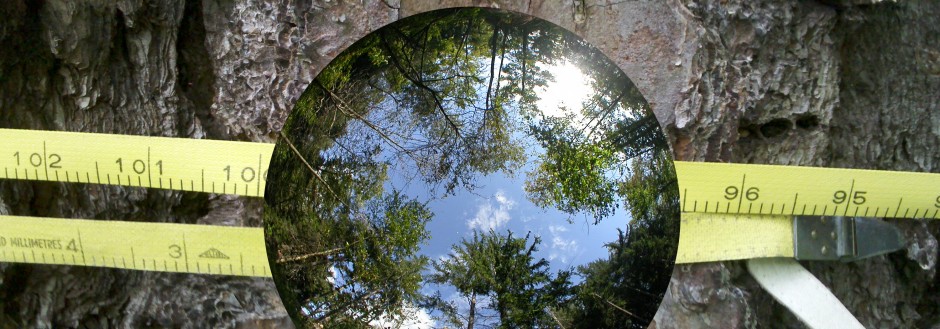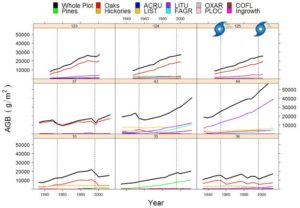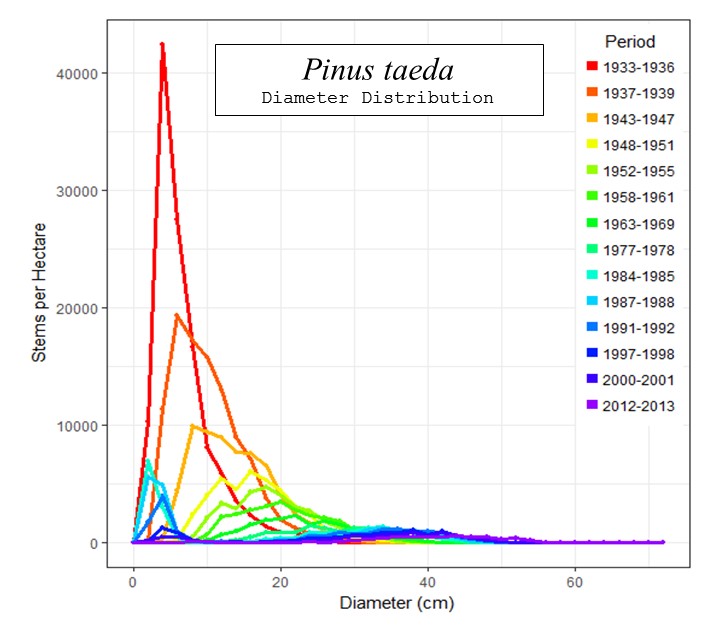My ongoing long-term forest research focuses on understanding the dynamics of forest communities and examining long-term forest growth of North Carolina Piedmont forests. Specifically, I am interested in examining recent growth trends and long-term successional patterns using spatially-explicit individual tree growth and mortality data located throughout the Duke Forest teaching and research laboratory.

I am currently focused on patterns of biomass accretion across time and the effects that major disturbances such as hurricanes are having on the observed patterns.
I am also interested in how various community types are changing throughout succession. Specifically, I am interested in examining whether successional pine stands are succeeding ‘towards’ the current hardwood forests as is expected or towards a different novel community type.
Further, I am trying to correlate any unexpected shifts in successional direction and rate to various stressors and disturbances, such as those attributed to long-term climate change, increased herbivory pressure from deer and periodic hurricanes.
Lastly, using a collection of many multivariate analyses, my research seeks to demonstrate the need for an extended suite of ecological indicators for predicting successional change and outcomes. With one of the longest-running forest growth data sets in the world, I believe I have a unique opportunity to expand the field’s knowledge of secondary succession, one of the foundational concepts in ecology!
Using 80 years or resampled permanent sample plot data in the Piedmont of NC, my research questions the simplicity of the typical linear, single-disturbance model of secondary forest succession with single steady-state terminus developed by classic chronosequence studies almost 100 years ago in similar Piedmont forests. Instead, our work supports the need for a more complex, stochastic model with multiple potential outcomes that are continuously dependent on a broad suite of potential drivers (including ongoing and novel disturbances).

Proposed suite of indicators of forest successional change. This broader suite of indicators combines traditional usage of species abundances and site attributes with novel drivers of change identified from 80 years of permanent sample analyses in the Duke Forest, NC (USA). The graphic reimagines the linear, climax-based successional trajectory often depicted in ecology textbooks as a more stochastic process. Instead of one terminus (i.e., “climax”), our reimagined graphic shows multiple potential outcomes that are dependent on the suite of drivers involved. The double arrow indicates that variable combinations of these drivers can occur at various stages of succession – the relative timing of involved drivers potentially having varying impacts on successional outcomes. Payne & Peet (2023)
- Payne C. J. and R. K. Peet. 2023. Revisiting the model system for forest succession: Eighty years of resampling Piedmont forests reveals need for an improved suite of indicators of successional change. Ecological Indicators 154:110679. https://doi.org/10.1016/j.ecolind.2023.110679





